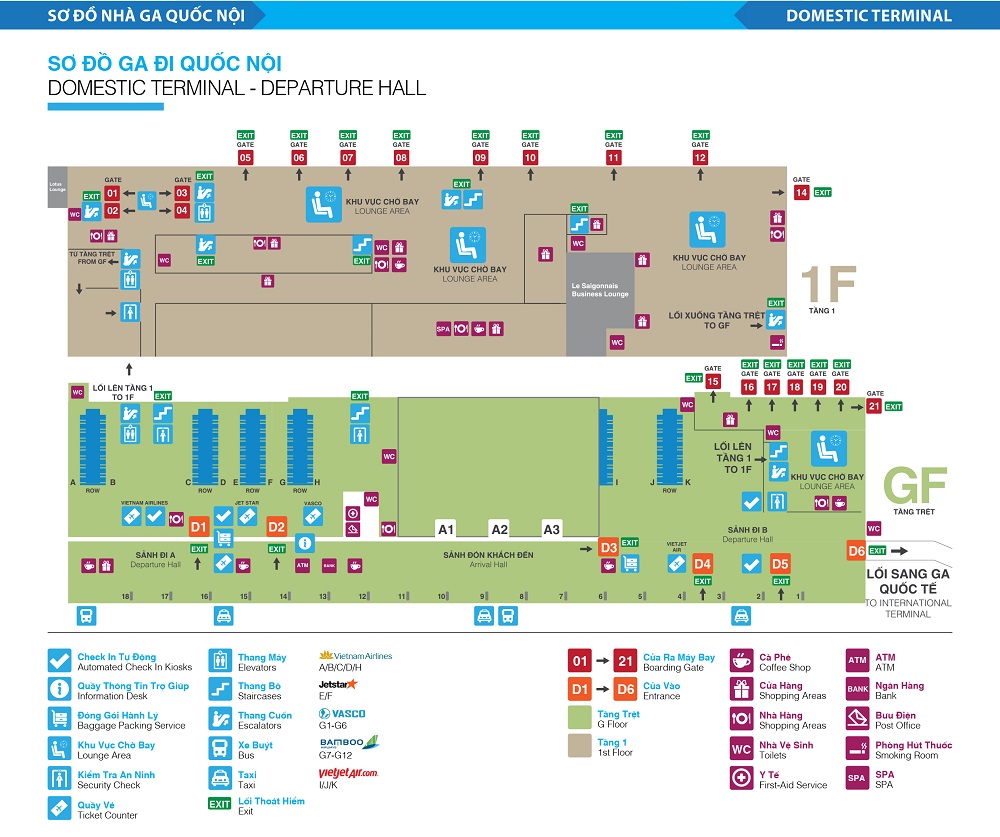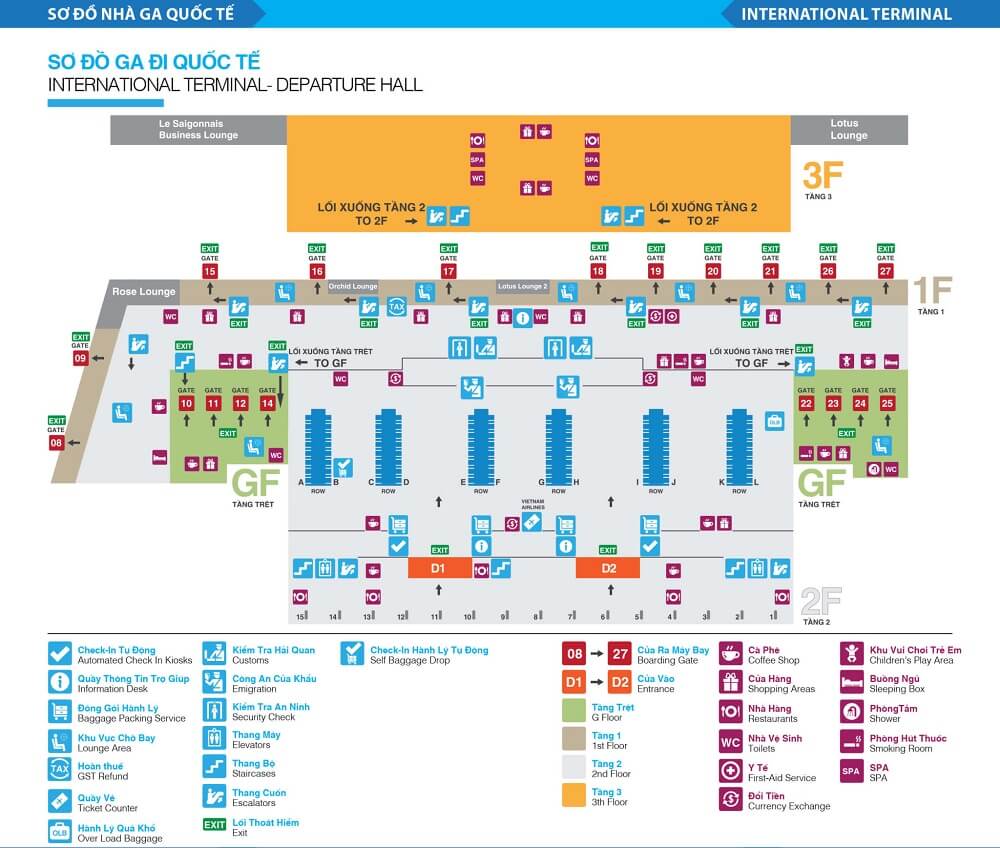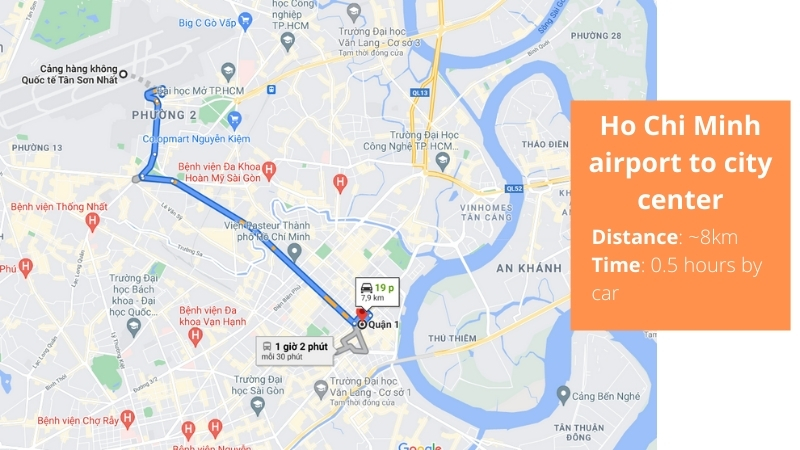Tan Son Nhat International Airport - Ho Chi Minh City Guide
Tan Son Nhat International Airport or Saigon Airport (Vietnamese Name: Cảng Hàng Không Quốc Tế Tân Sơn Nhất) with an area of 850ha is the biggest airport in Vietnam in terms of area as well as terminal capacity and the airport with the largest number of passengers in Vietnam. Located 8 km from the center of Ho Chi Minh City to the North, in Tan Binh District, Tan Son Nhat International Airport is an important traffic hub of the South. This is also one of 3 busiest airports in Vietnam with other Noi Bai International Airport in Hanoi and Da Nang International Airport in Central Vietnam.
- Location: Ward 2, Tan Binh District, Ho Chi Minh City, Vietnam
-
Tan Son Nhat International Airport Code:
- IATA (International Air Transport Association) code: SGN
- ICAO (International Civil Aviation Organization) code: VVTS

History of Tan Son Nhat International Airport:
The airport was originally built by the French colonialists in 1930 on most of the area of Tan Son Nhut village, northwest of Saigon city. The first flight from Paris to Saigon at Tan Son Nhat airport was in 1933, this flight lasted 18 days. In 1937, France established the Civil Aviation Department of Indochina.
In 1956, the US Government supported the construction of a wider airport, more than 3000 m long with concrete, compared to the airport built by the French colonialists in the past, longer than 1500 m with only red soil. The land fund of the Republic of Vietnam for long-term development of the airport is about 3,600 hectares, three times the current land fund of Singapore's Changi Airport.

During the Vietnam War, Saigon Tan Son Nhut airport was an important military base for the US Army and the Republic of Vietnam Air Force. During this period, Tan Son Nhut airport was one of the three busiest airports in the world.
After the reunification of Vietnam, facilities continued to be built to operate domestic and international flights. However, compared to the land area, the airport in 2016 was only 1/4 of the area compared to Saigon Tan Son Nhut airport before 1975. The northeastern part of this airport has turned into a golf course named Tan Son Nhat golf course occupies 160 hectares of land.

In 1986, the VI Congress of the Communist Party of Vietnam took place from December 15 to 18, marking a major milestone for the comprehensive change in Vietnam. The subsidized economy was abolished, the economic management mechanism and the way of industrialization were comprehensively reformed.
Tan Son Nhat Airport’s Passenger Terminals and Facilities:
Following the opening of its new international terminal in September 2007, Tan Son Nhat has two major terminal buildings with separate sections for international and domestic flights.
- Domestic Terminal (T1):
The current domestic terminal building was originally constructed in 1963 by RMK-BRJ. After years of constant expansion to meet growing traffic, the handling capacity of the terminal grew tenfold to 15 million passengers a year as of 2023. It has a floor area of 40,948 m2 (440,760 sq ft) with 20 boarding gates (4 aerobridge gates and 16 remote gates). The terminal has two lounges in operation: Lotus Lounge and Le Saigonnais Lounge.
- International Terminal (T2):
A new international terminal funded by Japanese official development assistance and constructed by a consortium of four Japanese contractors (KTOM, abbreviation of four contractors' names: Kajima – Taisei – Obayashi – Maeda), opened in September 2007 with an initially designed capacity of 10 million passengers a year.
In 2014, the terminal served over 9 million international passengers and a demand of an expansion to the terminal was in sight. The first phase of an urgent expansion to the terminal was finished in December 2016 with an addition of 2 new jet bridges and other facilities. Upon the completion of phase two, the terminal has a floor area of 115,834 m2 (1,246,830 sq ft) and can handle 13 million passengers annually.
There are a total of five passenger lounges situated in the International Terminal: Lotus Lounge 1 and 2, Le Saigonnais, Orchid Lounge, and Rose Business Lounge.
- New Airport Terminal 3:
A new passenger terminal for the airport broke ground on December 24, 2022. The new terminal will include 27 gates (13 jetbridges and 14 remote gates) for an annual handling capacity of 20 million passengers. The terminal building will have a total floor area of 112,500 m2 (1,211,000 sq ft), and will be connected with a new 130,000 m2 (1,400,000 sq ft) non-aviation services and parking complex by footbridges. The project has a budget of 10,986 billion VND (US$467.6 million) and is projected to be completed by the end of 2024. Upon completion, the terminal will serve domestic flights to support the current domestic terminal.
Public Transportation in Tan Son Nhat Airport:
Saigon Bus 109 is a special airport shuttle bus running from Tan Son Nhat International Airport (SGN) to Ho Chi Minh City Center. Bus 109 route connects Saigon Airport’s domestic and international terminals with District 1 of Ho Chi Minh City and Saigon Bus Station.

Airport Bus 109 is currently the best public transportation option for tourists traveling from Ho Chi Minh Airport to the city center. Bus 109 departs from Tan Son Nhat Airport, runs directly to District 1 and ends the journey at Saigon Bus Station, which is located next to 23/9 Park and backpacker district. Traveling on this bus is less time consuming than taking another public bus because there are fewer stops on the route. Buses used on this route are spacious so you can take even big luggage with you.
See Also:

Best of Vietnam

Best Vietnamese Food You Have to Try in Vietnam
Best Food in Vietnam: Vietnamese Traditional Food is top World well known to be both healthy and...

10 Best National Parks in Vietnam
Vietnam Travel Guide: If you look for the Best Wildlife Discovery Experience in Vietnam, here are...
Read More
Best Souvenir to Buy in Vietnam
If you look for Best Things to Buy when traveling to Vietnam to bring home for your family & friends...
Read More
The 10 Best Places to Visit in Vietnam
Vietnam Travel Guide: Home to an extensive collection of historical and cultural attractions,...
Read More
Top 10 Museums You Should Not Miss in Vietnam
Vietnam, 4.000 years old country has a unique and lengthy history, culture with 54 ethnic groups. It...
Read MoreFind your trip
Vietnam Best Tours
Vietnam Car Rental
Vietnam Travel Blog
- Vietnamese People: Origin, History, Culture and Traditions
- Vietnam Currency: Best ATM and Places to Exchange Money
- Vietnam Map: Regions, Cities & Provinces Map of Vietnam
- What is illegal Things in Vietnam: Rules & Laws for Tourists
- Best Time to Travel to Vietnam to Avoid the Bad Weather
- Vietnam News: Population & Religions of 54 Ethnic Groups









